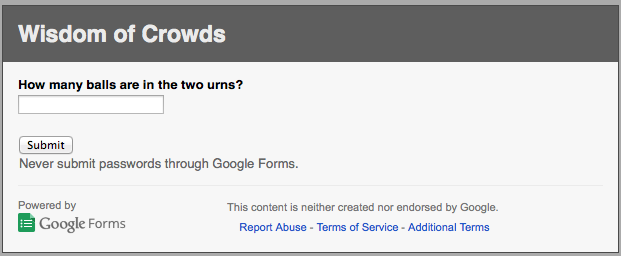Using Props in Lectures
I am ambivalent about using props in class. Used well, props can illustrate an important point or concept. Sometimes props can surprise or entertain students such that the lesson is more memorable. They’re fun. On the other hand, props can cheapen the whole educational enterprise and make it look like you are trying too hard. Shouldn’t the material itself be enough to engage the audience? I’m not totally sure where my performance at the beginning of Friday’s lecture falls, but I hope it was on the positive side.
It used to be that every intro probability/statistics book explained the basics with balls and urns. These books were filled with examples like “If I have 10 orange balls and 10 green balls in an urn, and I choose 3 randomly, what’s the probability that all three are the same color?” The problems were dry, but crystal clear. I wanted to bring them to life in class with real urns and balls.
Over the summer I asked the Peabody Museum if they would loan me some ancient urns from their collection, but alas, they declined to trust me with any priceless artifacts. Luckily Home Depot was happy to let me buy a couple big ones and then take advantage of their generous return policy. Alex Dorato, the head coach of the men’s tennis team, contributed a whole load of used tennis balls, and I was off and running.
I couldn’t think of an educational reason to have students actually reaching in and picking balls from the urns, but I wanted them to be actively engaged. Instead, I decided to demonstrate the Wisdom of the Crowds, and while they were filing into the room, I filled both urns to the brim with tennis balls. Each student had to guess how many balls were in the two urns. This was a lot more practical than bringing in a real ox to replicate Francis Galton’s original “experiment.”

130 students typed their guess into a Google form during the first couple minutes of class and I immediately slurped the data into Stata. After a removing a few smart-alec answers (e.g., -47000 and 1e20) the mean guess was 422–remarkably close to the true answer of 489. I breathed a big sigh of relief when the exercise actually worked: The mean (“crowd-sourced”) guess was closer to the true answer than 83% of the individual guesses.
The rest of the lecture went a lot more smoothly than Monday’s: The projector displayed my slides, my notes app stayed up, and I ended class at the correct time. There was still plenty of room for improvement. I didn’t leave quite enough time to go over the last problem carefully and ended up making a mistake that had to be corrected with an email announcement that evening. My handwriting was atrocious and my slide space management was poor. It didn’t take long for these skills to atrophy after a summer of working on them, but I’m optimistic that with a bit of practice they will return.
1 week down, 12 to go!